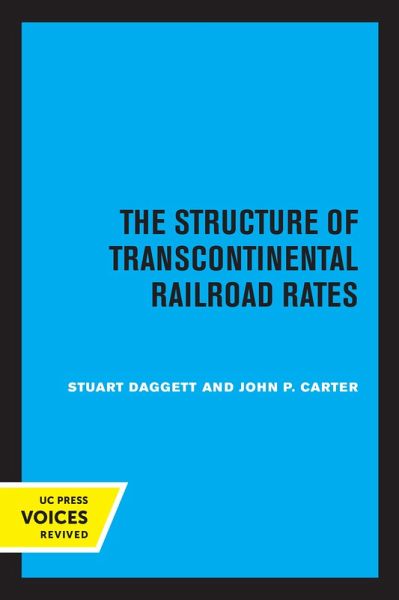
The Structure of Transcontinental Railroad Rates (eBook, ePUB)
A Publication of the Bureau of Business and Economic Research, University of California

PAYBACK Punkte
9 °P sammeln!
The Structure of Transcontinental Railroad Rates by Stuart Daggett and John P. Carter provides a detailed examination of how freight rate systems shaped-and constrained-the economic life of California during the mid-twentieth century. Drawing on published tariffs from 1943-1944 and comparative data supplied by carriers, the authors unpack the mechanics of rate-making, the geography of western rail routes, and the competitive interplay between railroads, highways, and intercoastal shipping. Their analysis foregrounds the immense challenges of distance, topography, and sparse population across t...
The Structure of Transcontinental Railroad Rates by Stuart Daggett and John P. Carter provides a detailed examination of how freight rate systems shaped-and constrained-the economic life of California during the mid-twentieth century. Drawing on published tariffs from 1943-1944 and comparative data supplied by carriers, the authors unpack the mechanics of rate-making, the geography of western rail routes, and the competitive interplay between railroads, highways, and intercoastal shipping. Their analysis foregrounds the immense challenges of distance, topography, and sparse population across the intermountain states, while also showing how carriers maintained dense main-line traffic despite weak local originations. The book illuminates how elevation, curvature, and ruling grades translated directly into costs and, in turn, into the complex tariff structures governing California's eastbound and westbound trade. Beyond physical geography, the study delves into the institutional frameworks of rate bureaus, the distinctions between class and commodity rates, and innovations such as all-freight rates introduced to meet highway and water competition. With careful attention to technical detail, Daggett and Carter reveal the ways tariffs grouped western termini, segmented eastern destinations, and influenced pricing outcomes for commodities ranging from perishables to manufactured goods. While acknowledging the methodological challenges of sampling and causal inference, they nonetheless present a clear and systematic account of transcontinental freight charges as both an economic reality and a policy issue. For historians of transportation, economists of infrastructure, and policy specialists concerned with the integration of regional markets, this monograph remains an invaluable resource for understanding how railroad rates underpinned California's wartime and postwar development. This title is part of UC Press's Voices Revived program, which commemorates University of California Press's mission to seek out and cultivate the brightest minds and give them voice, reach, and impact. Drawing on a backlist dating to 1893, Voices Revived makes high-quality, peer-reviewed scholarship accessible once again using print-on-demand technology. This title was originally published in 1947.
Dieser Download kann aus rechtlichen Gründen nur mit Rechnungsadresse in A, D ausgeliefert werden.













